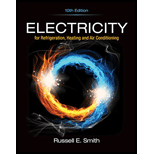
Electricity for Refrigeration, Heating, and Air Conditioning (MindTap Course List)
10th Edition
ISBN: 9781337399128
Author: Russell E. Smith
Publisher: Cengage Learning
expand_more
expand_more
format_list_bulleted
Concept explainers
Textbook Question
Chapter 5, Problem 27RQ
Change the following normally open elements from the de-energized position to the energized position.

Expert Solution & Answer
Want to see the full answer?
Check out a sample textbook solution
Students have asked these similar questions
Define the following,Joint.Link.Joint space.Actuator space.
What kind of material is used in the waterless groundloop in a waterless, earth-coupled, closed-loop geothermalheat pump system?
3. A contact device installed at the outlet for the connection of a single attachment plug. a. male plug b. switch c. female plug d. receptacle
Chapter 5 Solutions
Electricity for Refrigeration, Heating, and Air Conditioning (MindTap Course List)
Ch. 5 - What are the three types of electrical diagrams...Ch. 5 - A load is an electrical device that __________. a....Ch. 5 - What is the major load of an air-conditioning...Ch. 5 - Identify the following symbols for loads:Ch. 5 - Prob. 5RQCh. 5 - What do the terms normally open and normally...Ch. 5 - What is the difference between a magnetic starter...Ch. 5 - Prob. 8RQCh. 5 - Draw a heating and a cooling thermostat and...Ch. 5 - A three-pole contactor would allow how many paths...
Ch. 5 - A disconnect switch is used to __________. a. open...Ch. 5 - What determines whether a pressure switch opens or...Ch. 5 - Identify the following symbols for...Ch. 5 - What is the difference between a thermal overload...Ch. 5 - What is the purpose of a transformer? Draw the...Ch. 5 - Which of the following is not a requirement for an...Ch. 5 - What is the purpose of a legend on a schematic...Ch. 5 - A factual diagram is _____. a. a pictorial diagram...Ch. 5 - Identify the following symbols for safety devices.Ch. 5 - Prob. 20RQCh. 5 - True or False: The schematic diagram tells service...Ch. 5 - What is the difference between a pilot duty and a...Ch. 5 - What type of switch would be used to open or close...Ch. 5 - What is the purpose of a fuse in an electrical...Ch. 5 - True or False: A solenoid valve is a device that...Ch. 5 - What is a signal light used for in a control...Ch. 5 - Change the following normally open elements from...Ch. 5 - Draw the symbols for the following electrical...Ch. 5 - Add letter designations to the symbols to indicate...Ch. 5 - Draw a symbol for a magnetic starter.
Knowledge Booster
Learn more about
Need a deep-dive on the concept behind this application? Look no further. Learn more about this topic, mechanical-engineering and related others by exploring similar questions and additional content below.Similar questions
- The large interconnecting line between the indoor and outdoor coil is the _____line.arrow_forwardWhat is an SPST switch?arrow_forwardAn open winding in an electric motor means that A. the winding is making contact with the motor frame. B. one winding is making contact with another winding. C. a wire in one winding is broken. D. the centrifugal switch to the start winding is open.arrow_forward
arrow_back_ios
arrow_forward_ios
Recommended textbooks for you
 Understanding Motor ControlsMechanical EngineeringISBN:9781337798686Author:Stephen L. HermanPublisher:Delmar Cengage Learning
Understanding Motor ControlsMechanical EngineeringISBN:9781337798686Author:Stephen L. HermanPublisher:Delmar Cengage Learning Refrigeration and Air Conditioning Technology (Mi...Mechanical EngineeringISBN:9781305578296Author:John Tomczyk, Eugene Silberstein, Bill Whitman, Bill JohnsonPublisher:Cengage Learning
Refrigeration and Air Conditioning Technology (Mi...Mechanical EngineeringISBN:9781305578296Author:John Tomczyk, Eugene Silberstein, Bill Whitman, Bill JohnsonPublisher:Cengage Learning Automotive TechnologyMechanical EngineeringISBN:9781337794213Author:ERJAVEC, Jack.Publisher:Cengage,
Automotive TechnologyMechanical EngineeringISBN:9781337794213Author:ERJAVEC, Jack.Publisher:Cengage, Welding: Principles and Applications (MindTap Cou...Mechanical EngineeringISBN:9781305494695Author:Larry JeffusPublisher:Cengage Learning
Welding: Principles and Applications (MindTap Cou...Mechanical EngineeringISBN:9781305494695Author:Larry JeffusPublisher:Cengage Learning Automotive Technology: A Systems Approach (MindTa...Mechanical EngineeringISBN:9781133612315Author:Jack Erjavec, Rob ThompsonPublisher:Cengage Learning
Automotive Technology: A Systems Approach (MindTa...Mechanical EngineeringISBN:9781133612315Author:Jack Erjavec, Rob ThompsonPublisher:Cengage Learning

Understanding Motor Controls
Mechanical Engineering
ISBN:9781337798686
Author:Stephen L. Herman
Publisher:Delmar Cengage Learning

Refrigeration and Air Conditioning Technology (Mi...
Mechanical Engineering
ISBN:9781305578296
Author:John Tomczyk, Eugene Silberstein, Bill Whitman, Bill Johnson
Publisher:Cengage Learning

Automotive Technology
Mechanical Engineering
ISBN:9781337794213
Author:ERJAVEC, Jack.
Publisher:Cengage,

Welding: Principles and Applications (MindTap Cou...
Mechanical Engineering
ISBN:9781305494695
Author:Larry Jeffus
Publisher:Cengage Learning

Automotive Technology: A Systems Approach (MindTa...
Mechanical Engineering
ISBN:9781133612315
Author:Jack Erjavec, Rob Thompson
Publisher:Cengage Learning
Hydronics Step by Step; Author: Taco Comfort Solutions;https://www.youtube.com/watch?v=-XGNl9kppR8;License: Standard Youtube License